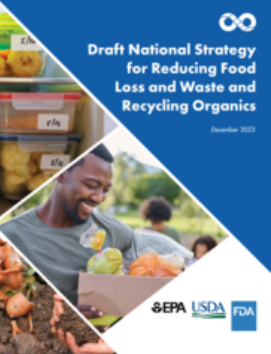|
|
January 18, 2022
|
This e-newsletter delivers announcements from EPA's Office of Resource Conservation and Recovery on rulemakings, guidance documents, reports, research, upcoming webinars, and more.
|
|
|
a Best Practices Guide for Construction & Demolition Landfills in Indian Country

In December 2023, EPA posted the guide “Construction & Demolition Landfills in Indian Country: Federal Regulations and Best Practices” to help Tribal Governments and others involved in the decision to site or continue the operation of a C&D landfill in Indian country. The Guide helps Tribal Governments answer the following questions:
1. Are we making this decision based on our responsibility as stewards of the land, human health, wildlife, and natural resources?
2. Are we making this decision based on current and verified information about current and future waste generation and waste management options with a focus on waste prevention and reduction?
3. Based on this information, should we build a C&D landfill, continue to operate our existing landfill, or use landfills outside the reservation?
The Guide provides best practices and information on regulatory requirements for Tribal Governments to site, operate, and close C&D landfills; and to build capacity to regulate C&D landfills in Indian country. EPA gives tremendous thanks to the Tribal Governments who provided input and perspective to the Guide:
-
Blackfeet Nation
- Grand Portage Band of Lake Superior Chippewa
- Keweenaw Bay Indian Community
- Lac du Flambeau Band of Lake Superior Chippewa
- Prairie Band Potawatomi Nation
- White Earth Band of Chippewa
|
|
|
EPA Encourages Communities to Become More Resilient and Create Natural Disaster Debris Plans

On December 18, 2023, EPA put out an animation to show that communities with debris plans and resiliency measures in place are more resilient when natural disasters occur. Resilient communities need fewer resources to rebuild, contain less harmful materials, generate less debris, and recover faster. Communities can act now to reduce the volume of debris that needs to be cleaned up. Even after a disaster, communities can implement resiliency measures to manage debris more sustainably and reduce the volume of waste. Check out the animation on YouTube.
|
|
|
Comment Now on Version 16 of the Waste Reduction Model

On December 26, 2023, EPA opened a 45-day comment period on the Waste Reduction Model version 16 and its supporting documentation. EPA seeks comment through February 9, 2024.
WARM v16 contains updates to several materials including food waste, mixed electronics, and the wood product construction and demolition materials. EPA also updated economic factors in WARM, based on newly available data. Access Version 16 on the WARM website.
|
|
|
Publishes Information about the Hazardous Waste Incinerator Backlog
On January 8, 2024, EPA posted information on options for hazardous waste generators and treatment, storage and disposal facilities for dealing with the backlog of containerized hazardous waste needing incineration. The incinerator backlog has persisted longer than initially anticipated, prompting EPA to remain in frequent contact with affected parties. This new webpage discusses this issue and provides answers to frequent questions from our discussions. Check out the new webpage.
|
|
Join Us on Jan 30th for a Webinar: “Information Overload: Getting the EPA Information You Want and

Join Carolyn Hoskinson, Director of EPA’s Office of Resource Conservation and Recovery, in an engaging webinar where ORCR will discuss the various communication avenues we use to share information with Tribal communities. You will also learn from a Tribal speaker as they share best practices and challenges in filtering and disseminating information within their community. Finally, you will have a chance to provide feedback and input to improve ORCR’s communication and collaboration with Tribes. Be part of the conversation, contribute your insights and influence positive changes in the Tribal Waste Management Program!
Time: 3:00- 4:00 pm Eastern Time
|
|
|

In December 2023, EPA, USDA, and FDA are pleased to announce the draft “National Strategy for Reducing Food Loss and Waste and Recycling Organics.” The goal of the strategy is to prevent the loss and waste of food and other organic materials to support a more circular economy for all, reduce greenhouse gas emissions, save households and businesses money, and build cleaner, healthier communities. The actions detailed in this strategy will help the U.S. meet its national food loss and waste reduction goal to halve food loss and waste. They will also contribute to meeting the national recycling goal to achieve a 50% recycling rate by 2030 and to global achievement of the United Nations Sustainable Development Goal Target 12.3.
The strategy identifies concrete steps, and complementary EPA, USDA, and FDA actions, that will accelerate the prevention of food loss and waste, and the recycling of the remaining organic waste across the entire supply chain. The four main objectives of the strategy are:
-
Prevent the loss of food where possible.
-
Prevent the waste of food where possible.
-
Increase the recycling rate for all organic waste.
-
Support policies that incentivize and encourage food loss and waste prevention and organics recycling.
Comment through February 3, 2024 on Regulations.gov, Docket ID No. EPA-HQ-OLEM-2022-0415.
|
|
|
|
|
|